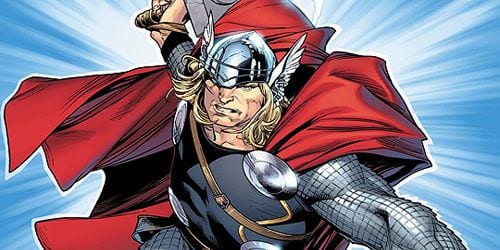
The character, one of the longest-standing heroes in the Marvel pantheon (to say nothing of the mythology from which he was plucked), was absent while a sea of change swept through the world he had known.
He returns to an uneasy land of divided heroes. He learns that while he was absent, his genetic code had been used in the Civil War between the superheroes. And while he is at work rebuilding his life and awakening his fellow Asgardians, Iron Man shows up, advises him of the new way of things, and then demands compliance.
Not the brightest idea Tony Stark has ever had.
The difference in this new incarnation of Thor is clearly illustrated in what happens next (destined from its inception for fan-favorite greatness). As Thor himself says, he is no longer holding back. Thus, the no doubt well-intentioned plan by Tony Stark to lay down the law for the newly risen Thor and for Asgard itself is not exactly met with quiet deference.
Put simply, Thor smacks Iron Man down without breaking a sweat, leaving Stark’s armor in total systems failure and the man himself stammering up a diplomatic compromise in the mud and the rain.
The first story arc of his brand new series — in which the Norse god of thunder returns from oblivion and begins to call Asgard and its citizens back into being — has a distinct Lee/Kirby kind of flavor; a balanced sprinkling of camp and even some reflection on real world problems outside the traditional realm of superheroes.
Thus, Thor visits post-Katrina New Orleans and Dr. Donald Blake, his mortal incarnation, is called upon to assist with a medical mission in a war-torn refugee camp.
Other writers have tackled that particular tangle of thorns — why superheroes, with all their power, cannot fix all the woes of the world — with varying degrees of success, but Straczynski seems to deliver a reasonable answer: salvation never comes from outside. Anyone who wants to see change can’t wait on the day a superman floats down from the sky to deliver it.
The story would sag too heavily were the commentary on the sad state of the world and the tension of the post-Civil War community of heroes carried too far. And so we also have Asgard in the American Heartland (the property above which it hovers paid for in a pickup truck-load of Asgardian gold), Volstagg in a town meeting revealing the time-honored means of waste disposal in a walled city of gods, and a short-order cook contemplating the courtship of a goddess.
Good stuff.
Aside from the relocation of Asgard to Oklahoma, of course, the most significant difference between the old and the new world of Thor thus far seems to be the female incarnation of Loki.
In traditional tales of Norse mythology, Loki might one afternoon shift sex and even species, receive the amorous advances of a great steed, bear young from that union, change back to his more familiar form, and go on about his day without much more than an “at least I didn’t have to cook him breakfast” shrug. Trickster gods tend to be like that.
Be that as it may, Loki’s gender bend may well scare up some interesting plot twists for the mainstream Marvel Universe, which has traditionally shied away from the more brow-raising anecdotes found within world myth.
The series shows great promise in both its fresh take on the characters and its respect for what made the classic Silver and Bronze Age tales of the thunder god so much fun to read.
Already, early on, we have the Destroyer, the Enchantress, and the Warriors Three . . . all the players falling into place. As Dr. Donald Blake’s hostess notes, in the very first issue, a thunderstorm is expected. You can feel the charge gathering in the air.

![Call for Papers: All Things Reconsidered [MUSIC] May-August 2024](https://www.popmatters.com/wp-content/uploads/2024/04/all-things-reconsidered-call-music-may-2024-720x380.jpg)



